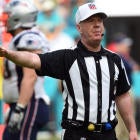Last season, Zebra Technologies brought next-gen stats to the NFL by implementing their RFID chips in NFL players' pads to track speed, distance covered, acceleration and deceleration. In 2017, however, they're taking it a step further by implementing their tags into NFL balls themselves on NFL Sundays. The chips will measure things like rotation, ball speed and ball location throughout games. Zebra is entering its fourth year in a partnership with the NFL, and this was tested during preseason and Thursday Night Football games.
There are myriad reasons that this technology is being implemented. Obviously the fan experience is a key component, and NFL broadcasters will be using this data in order to enhance the experience for fans watching. Ball data is also going to work twice as fast as player data, since the ball obviously moves at drastically higher speeds than a player. It will be capturing 25 data points per second throughout the game.
As for the ball itself, the chip obviously won't affect things like weight or rotation. The chips were designed in a close partnership between Zebra, the NFL and Wilson, and meet all specifications for gameday footballs. Teams will also begin using the chips in practice to measure quarterbacks and special teams, while the league continues to think of the best uses for this technology.
The full potential of RFID tags is still far from tapped, but the possibilities for the technology are nearly endless. For starters, the measurement of location could be used to take the subjectivity out of spot measurements, depending on where and how the tags are implemented. Although this won't be happening in 2017, as Zebra continues its partnership with the NFL it's possible and even likely that we'll see technology play a significantly larger role in the minutia of NFL Sundays.

















